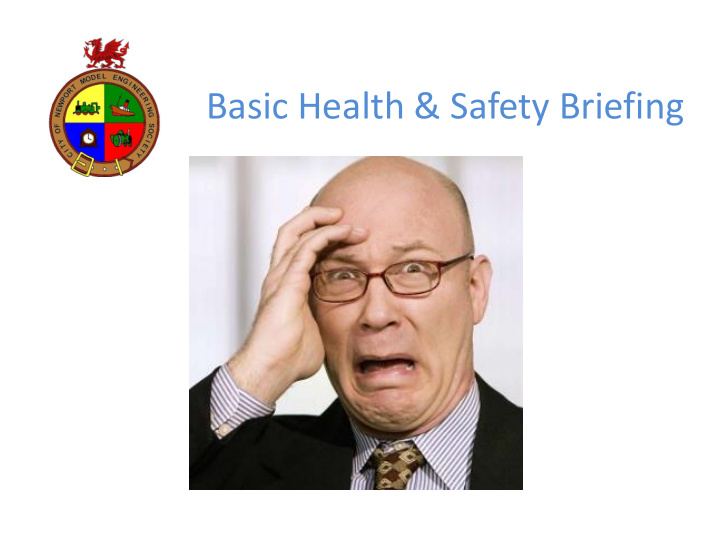



Basic Health & Safety Briefing
Basic Health & Safety Briefing New CNMES H&S Handbook • What everyone needs to know • How to handle emergencies • Where to find things • Routine things to do • Special job responsibilities • Your CNMES qualifications • Questions & discussion
What Everyone Needs to Know Page 1 & 2 of Handbook • Known risks (Annex A) • Reacting to an incident • Incident reporting (Annex B) • Photos & video (Annex E)
Known Risks & Mitigation Action Example table from Annex A: Table 2 – Normal Operation of the Model Railway - Members Only Ser Risk Description Potential Mitigation Impact 2-1 Collision with side Train crews and passengers risk injury and Severe Inspect track before every operation - trackside objects must be at least 600mm away from objects equipment risks damage caused by collision with the nearest rail. trackside objects. Track speed limit of 8mph except where otherwise indicated. Identify potential danger points and warn drivers and passengers. 2-2 Collision with Train crews and passengers risk injury and Severe Track speed limit of 8mph except where otherwise indicated. people equipment risks damage caused by collision with Mark suitable track crossing points with good visibility. other people. Maintain fences between the track and main pedestrian walkways. Identify potential danger points and warn drivers and pedestrians. Include track crossing rules in new members’ H&S briefing. 2-3 Runaway engine Train crews and passengers risk injury and Severe Drivers must be appropriately qualified (see Annex D). collision equipment risks damage caused by a runaway Couplings must comply with Society specification (see Annex C). engine. 2-4 Derailments Train crews and passengers risk injury and Severe Inspect track before every operation. equipment risks damage caused by derailment. Engines and carriages are subject to gauge checks before using the railway (see Annex C). Track speed limit of 8mph except where otherwise indicated. Identify potential danger points and warn drivers and passengers. Other tables cover risks & mitigations during: • Inter-club operation of the railway – visitors from other clubs • Operation of the railway on public open days • Operation of the portable track • Club site maintenance
Reacting to an Incident If you see an incident occurring (or about to occur) • Alert those involved and anyone in the area • Take any safe action to avert further damage/injury • If trained , apply first aid as necessary (kit in clubroom). • Ensure Duty Manager is aware of the incident • Assist in completing an Incident Report (if necessary)
Reporting an Incident Annex B of Handbook • Date, time, location & weather • Description of incident • Details of injuries ( any injury) • Emergency services? (RIDDOR) • Committee action (later)
Digital Images: Children under 18 Annex E of Handbook • Photos & video OK: • Unless permission refused • Publishing requires permission • No names Advice to Public (Open Days): “No need to obtain the permission but respect privacy and do not publish (web or social media)”
Special Jobs – Engine Drivers Annex D of Handbook • Insurance & boiler certification • Eligibility to drive at CNMES • Driver training • Track & coupling standards • Braking requirements • Raised track clearances • Signalling protocols (tbc)
Special Jobs – Duty Manager Page 12 of Handbook • 13 jobs listed - Duty Manager is #1 • Always a Duty Manager if site open • Prime responsibility is H&S • 1 st Question; Who is Duty Manager? Duty Managers are volunteers – be kind to them!
CNMES Qualifications Annex C of Handbook • Member • Duty Manager • Engine Driver • Guard • Station Loader • Ticket Seller • Points Operator • Steaming Bay Manager • Instructor • etc
Basic Health & Safety Briefing New CNMES H&S Handbook • What everyone needs to know • How to handle emergencies • Where to find things • Routine things to do • Special job responsibilities • Your CNMES qualifications • Questions & discussion
Recommend
More recommend